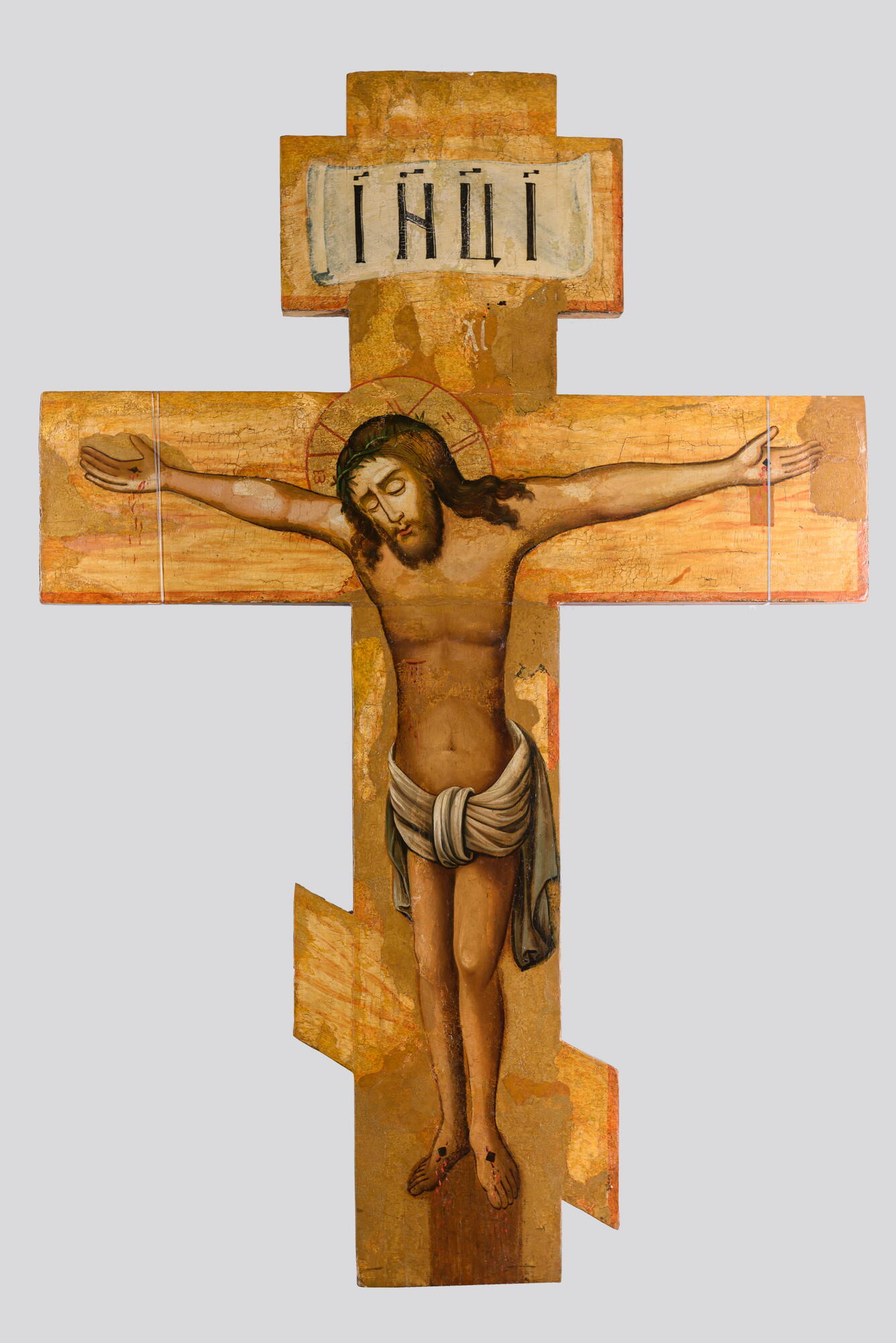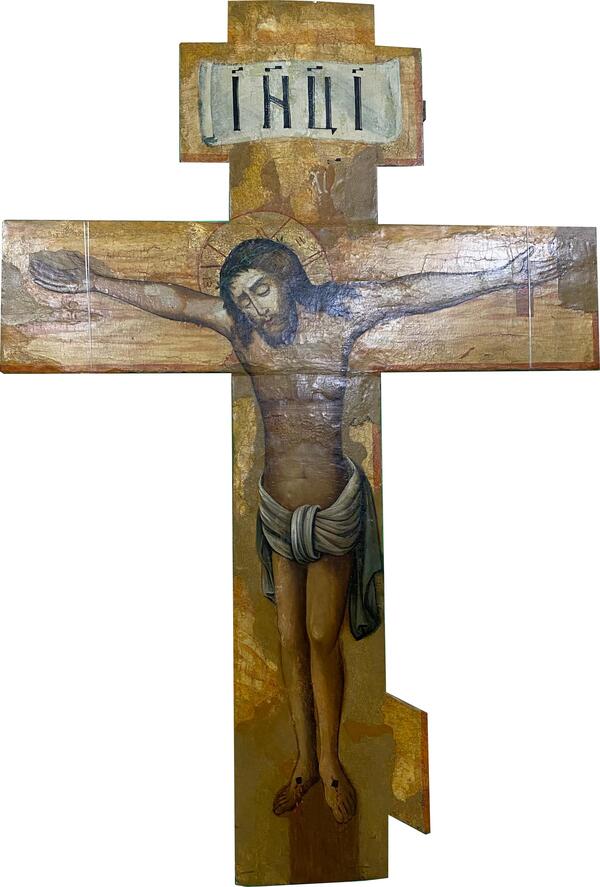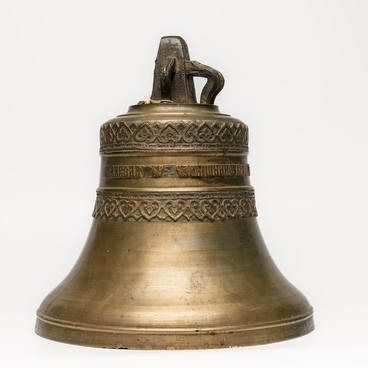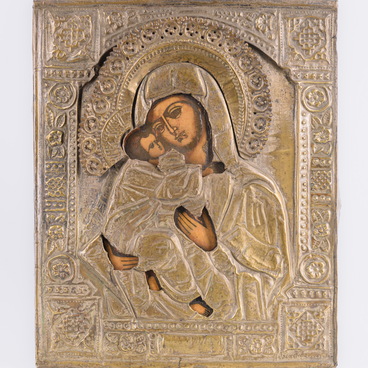The iconography of the Crucifixion of Christ has undergone a complex evolution, starting with the wall paintings in the Christian catacombs.
The first images (the 1st and 2nd centuries) were conventional, usually the Cross was replaced by an anchor, and Christ was represented as a fish. Researchers give two explanations for this. First, fearing persecution, Christians resorted to various ciphers. Second, it was the divine element of Sacred History that was important, while the earthly life of Christ was not as crucial.
In the next stage (the 4th century), there were images depicting human figures of Christ and the two criminals with their arms outstretched, as if on a cross, but without the crosses. The raised hands of Jesus were interpreted not so much as evidence of the agony of the cross, but as a gesture of blessing.
In the 5th century, the cross itself began to be included in the images, but the interpretation of the crucified Jesus remained the same: His eyes are open, His body is straightened and as if full of strength, He triumphs over death, and does not experience it as a human.
In the 7th century, heretical teachings were actively spreading in the East, in which doubts were expressed about the unity of the Divine and human nature of the Savior. At Ecumenical Councils, on the contrary, church leaders increasingly talked about the God-Man. As a result of this confrontation, a canonical image was formed in Byzantine iconography called Vir dolorum — “The Man of Sorrows”. Since that time, church art has included the image of the sufferings on the cross, and even the combination of suffering and triumph.
Russian icon painting reached its heyday in the 15th century. It was then that the most expressive images of the Crucifixion were created, which became guides for icon painters of the following centuries.
The presented icon board is made in the shape of a cross. The crucified Christ is painted at the moment after He died: His body hangs powerlessly on the cross, His eyes are closed, His lips are closed, but His face is calm: it was not death that has happened, but a triumph over death. The face, hands and body of Jesus are painted using chiaroscuro modeling.
Researchers attach deep symbolic significance to the nails driven into the palms of the Savior. This does not correspond to reality (in order for the executed to stay on the cross, the nails were pounded into the wrists), but it focuses the attention of the worshiper on the pierced hands, which until recently have healed the sick and blessed the suffering.
The icon comes from the Nativity Church in Balakhna. It entered the Balakhna Museum of Local History on February 28, 1977. In 2003, it was restored at the Moscow Interregional Scientific and Restoration Art Department, and in 2016 — at the Ilya Glazunov Russian Academy of Painting.
The first images (the 1st and 2nd centuries) were conventional, usually the Cross was replaced by an anchor, and Christ was represented as a fish. Researchers give two explanations for this. First, fearing persecution, Christians resorted to various ciphers. Second, it was the divine element of Sacred History that was important, while the earthly life of Christ was not as crucial.
In the next stage (the 4th century), there were images depicting human figures of Christ and the two criminals with their arms outstretched, as if on a cross, but without the crosses. The raised hands of Jesus were interpreted not so much as evidence of the agony of the cross, but as a gesture of blessing.
In the 5th century, the cross itself began to be included in the images, but the interpretation of the crucified Jesus remained the same: His eyes are open, His body is straightened and as if full of strength, He triumphs over death, and does not experience it as a human.
In the 7th century, heretical teachings were actively spreading in the East, in which doubts were expressed about the unity of the Divine and human nature of the Savior. At Ecumenical Councils, on the contrary, church leaders increasingly talked about the God-Man. As a result of this confrontation, a canonical image was formed in Byzantine iconography called Vir dolorum — “The Man of Sorrows”. Since that time, church art has included the image of the sufferings on the cross, and even the combination of suffering and triumph.
Russian icon painting reached its heyday in the 15th century. It was then that the most expressive images of the Crucifixion were created, which became guides for icon painters of the following centuries.
The presented icon board is made in the shape of a cross. The crucified Christ is painted at the moment after He died: His body hangs powerlessly on the cross, His eyes are closed, His lips are closed, but His face is calm: it was not death that has happened, but a triumph over death. The face, hands and body of Jesus are painted using chiaroscuro modeling.
Researchers attach deep symbolic significance to the nails driven into the palms of the Savior. This does not correspond to reality (in order for the executed to stay on the cross, the nails were pounded into the wrists), but it focuses the attention of the worshiper on the pierced hands, which until recently have healed the sick and blessed the suffering.
The icon comes from the Nativity Church in Balakhna. It entered the Balakhna Museum of Local History on February 28, 1977. In 2003, it was restored at the Moscow Interregional Scientific and Restoration Art Department, and in 2016 — at the Ilya Glazunov Russian Academy of Painting.



